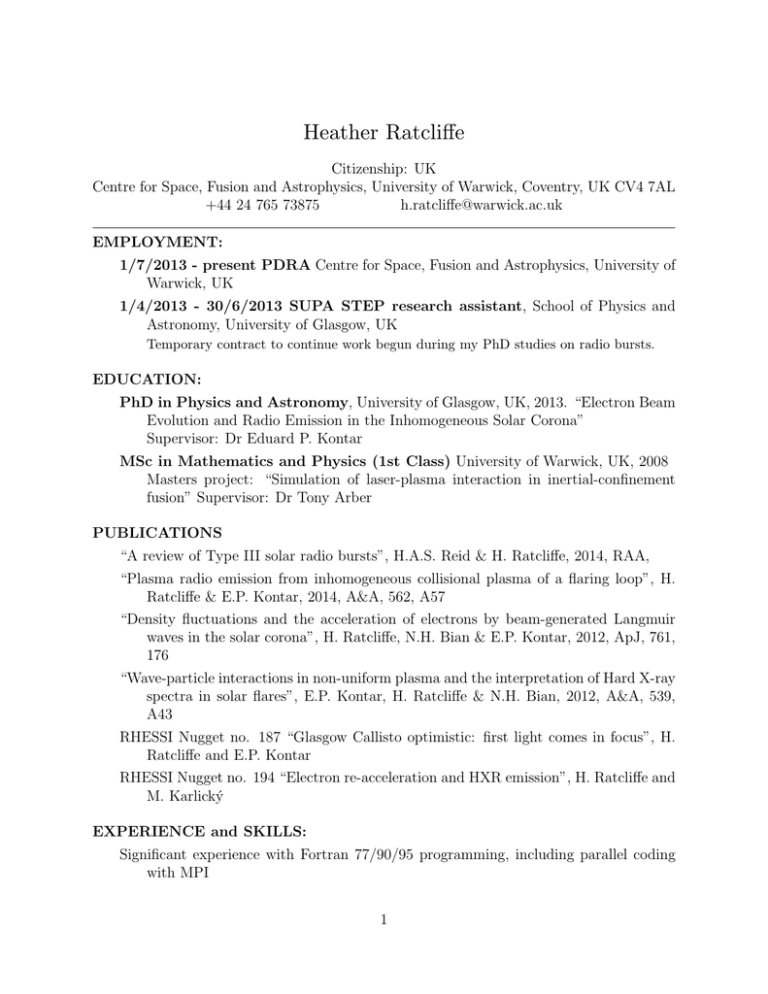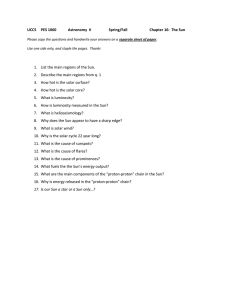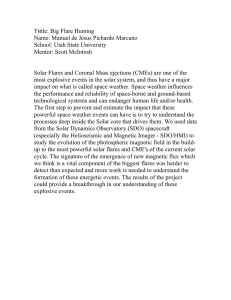Heather Ratcliffe
advertisement

Heather Ratcliffe Citizenship: UK Centre for Space, Fusion and Astrophysics, University of Warwick, Coventry, UK CV4 7AL +44 24 765 73875 h.ratcliffe@warwick.ac.uk EMPLOYMENT: 1/7/2013 - present PDRA Centre for Space, Fusion and Astrophysics, University of Warwick, UK 1/4/2013 - 30/6/2013 SUPA STEP research assistant, School of Physics and Astronomy, University of Glasgow, UK Temporary contract to continue work begun during my PhD studies on radio bursts. EDUCATION: PhD in Physics and Astronomy, University of Glasgow, UK, 2013. “Electron Beam Evolution and Radio Emission in the Inhomogeneous Solar Corona” Supervisor: Dr Eduard P. Kontar MSc in Mathematics and Physics (1st Class) University of Warwick, UK, 2008 Masters project: “Simulation of laser-plasma interaction in inertial-confinement fusion” Supervisor: Dr Tony Arber PUBLICATIONS “A review of Type III solar radio bursts”, H.A.S. Reid & H. Ratcliffe, 2014, RAA, “Plasma radio emission from inhomogeneous collisional plasma of a flaring loop”, H. Ratcliffe & E.P. Kontar, 2014, A&A, 562, A57 “Density fluctuations and the acceleration of electrons by beam-generated Langmuir waves in the solar corona”, H. Ratcliffe, N.H. Bian & E.P. Kontar, 2012, ApJ, 761, 176 “Wave-particle interactions in non-uniform plasma and the interpretation of Hard X-ray spectra in solar flares”, E.P. Kontar, H. Ratcliffe & N.H. Bian, 2012, A&A, 539, A43 RHESSI Nugget no. 187 “Glasgow Callisto optimistic: first light comes in focus”, H. Ratcliffe and E.P. Kontar RHESSI Nugget no. 194 “Electron re-acceleration and HXR emission”, H. Ratcliffe and M. Karlický EXPERIENCE and SKILLS: Significant experience with Fortran 77/90/95 programming, including parallel coding with MPI 1 Extensive use of IDL for plotting, and experience with SolarSoft tools, basic knowledge of scientific Python Good knowledge of LATEX typesetting, and basic knowledge of Linux operating system Languages: English (native), German (intermediate) ORGANISATION and TEACHING: Postgraduate Demonstrator for undergraduate astronomy lab sessions: University of Glasgow (2009-2012) Conference Assistance: I provided basic AV support and general organisation at both the 2010 National Astronomy Meeting in Glasgow and the 2011 RHESSI 11 workshop in Glasgow. STEM (Science, Technology, Engineering and Mathematics) Ambassador: University of Glasgow (2009-present) I have run observatory tours and planetarium shows for all ages. AWARDS and TRAVEL FUNDING: Travel and accomodation for 1 month under the IRSES RadioSun project to visit Pulkovo Observatory, St Petersburg, Russian Federation, Nov.-Dec. 2013. Young Scientist funding to attend the ISSI Team meeting on “X-ray and Radio Diagnostics of Energetic Electrons in Solar Flares”, Bern, Switzerland, Feb. 4 - 8, 2013 & Mar. 24-28, 2014 Studentship to attend the meeting “Tracing the Connections in Solar Eruptive Events”, San Francisco, Nov. 28th to Dec. 2nd, 2012. Studentship to attend the meeting of the Solar Physics Division of the American Astronomical Society in Anchorage, Alaska, June 10 - 14, 2012. Travel and accommodation for 3 one-week visits (2011-12) to Meudon Observatory, to work with Dr H Reid under the Alliance: Franco-British partnership research programme. SELECTED PRESENTATIONS: “Quasi-periodic pulsations in solar flares: microwave and HXR observations and electron transport simulations, RHESSI 13, Windisch, Switzerland, Apr. 1-4, 2014. SEMINAR: “Hard X-ray and radio observations of non-thermal electrons in solar flares”, UCLAN, Preston, UK, Feb. 19, 2014. “Hard X-ray and radio emission of fast electrons in the solar corona”, Ioffe PhysicalTechnical Insitute, St Petersburg, Russian Federation, Nov. 25, 2013. “Type III radio burst simulations in inhomogeneous plasma”, Workshop and School on Radio Sun, Beijing and Inner Mongolia, China, Oct. 28-Nov. 02, 2013 2 “Type III radio burst simulations in inhomogeneous plasma”, STEREO/WAVES & WIND/WAVES workshop on Solar Radio Emissions, Santorini, Greece, 7-11 Oct. 2013 “Simulations of 2 GHz plasma emission in the inhomogeneous solar corona”, at CESRA 2013, Prague, Czech Republic, June 24-30, 2013. POSTER: “ The effects of Langmuir wave evolution on Type III radio emission”, at the AGU Fall meeting, San Francisco, Dec. 3 - 7, 2012. “The effects of density gradients on Langmuir waves and electron beam propagation”, at the meeting “Tracing the Connections in Solar Eruptive Events”, San Francisco, Nov. 28th to Dec. 2nd, 2012. POSTER: “The effects of density fluctuations on electron beams and Type III radio bursts”, at the 5th Solar Orbiter workshop, Brugge, Belgium, Sept. 10 - 14, 2012 “Density fluctuations and electron acceleration by Langmuir waves”, at a GlasgowMeudon collaboration workshop, Glasgow, UK, June 25 & 26, 2012. POSTER: “Effects of Langmuir waves on flare-accelerated electrons in the inhomoge- neous coronal plasma”, at the 220th Meeting of the American Astronomical Society, Alaska, June 10 - 14, 2012. “Density fluctuations in the solar corona: effects on radio emission”, at the Young European Radio Astronomers Conference, UK, July 18 - 20, 2011. “The effect of Langmuir wave diffusion on electron distribution”, at RHESSI 11, UK, April 4 - 7, 2011. “The effect of density perturbations on Langmuir waves and electrons”, at the National Astronomy Meeting (NAM), UK, April 18 - 21, 2011. RESEARCH INTERESTS: My research covers a wide range of phenomena associated with solar flares and the resulting magnetic energy release and particle acceleration. Fast electrons accelerated in this way can lead to emission across the electromagnetic spectrum, from gamma rays to radio waves. Hard (high energy) X-rays and microwave emissions occur in coronal loops, close to the Sun and can serve as diagnostics of the plasma parameters, magnetic field structure and accelerated electrons. Time variations and periodicities (including quasi-periodic pulsations, QPP) in these emissions can provide information about the time-structure of electron acceleration, and the presence of magnetic-field-perturbing waves. Fast-drifting Type III radio bursts are seen from MHz down to kHz frequencies, and are due to electrons propagating away from the Sun. Type IV bursts arise from electrons trapped in coronal loops, and also show interesting time-variations due to, for example, waves propagating in these loops. I am interested in combined simulations and observations of these emissions, to provide information about fast electrons and therefore aid in understanding acceleration in solar flares. 3





